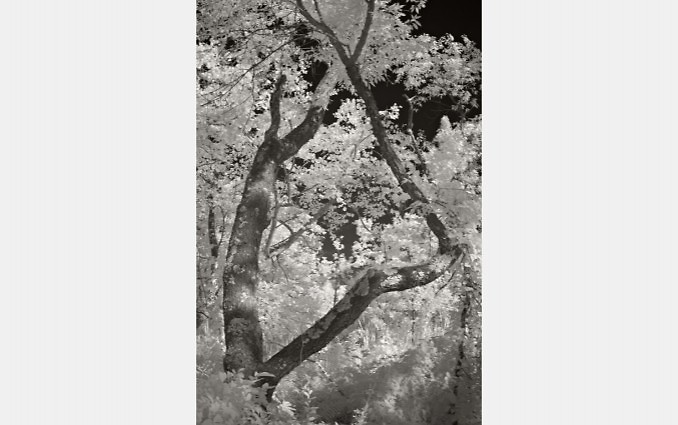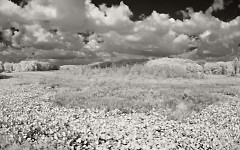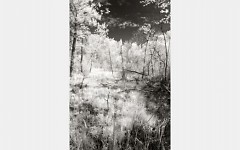“Concealed Wetlands: Rendering The Invisible” is a series of infrared photographs done by Taylor Bishop that promotes the preservation of wetlands across Michigan. At first glance, these photographs just seem like average photographs of wilderness and nature -- nothing special. But once the history and story behind this piece of work is known, one may realize the depth of these infrared photographs. The images are all of different scenes in Pierce Cedar Creek Wetlands. All of the images are in black and white, which adds to the bold statement being made in these photographs. The sky appears to be solid black or a gradient of greys, and the trees are shades of white and light grey in all of the images. Additionally, almost all of the natural elements look white and pure, while the atmosphere is dark and gloomy. The content of each image is almost surreal; the infrared style photographs, which captures the light that people cannot see with their naked eye and shows it as the image, gives it the surreal effect. This is a metaphor of the way that many people cannot see the destruction that is occurring in the wetlands. As he is displaying his infrared images at ArtPrize, he is also showing us the destruction of our wetlands.
Many people do not see the purpose of having wetlands in our ecosystem, or they just do not know the benefits of wetlands. For starters, wetlands prevent flooding. They retain water to keep river waters normal by holding or releasing water into it. They also help the ecosystem by feeding the fish nutrients and rejuvenating them from the damage that humans cause to rivers on an everyday basis. Additionally, wetlands clean the environment around them. Studies have found that the number of wetlands in Michigan have depleted drastically in the past 200 years, and that without these ecosystems life as we know it is in jeopardy.
Though the message behind these images is not apparent when first viewing the images, the idea that Taylor is going for is still very much present. The beauty of these images is a promotion to value nature because they show both the beauty of what nature is and also what it could be like if it was lost. These images display one of the few wetlands left in our great state. Taylor says that “capturing these images in infrared is symbolic of the limited spectrum of living we might experience one day if left unmanaged.” Taylor Bishop’s work is displayed at the Boardwalk Condominiums located at 940 Monroe Ave NW, Grand Rapids MI, 49503.
The Rapidian, a program of the 501(c)3 nonprofit Community Media Center, relies on the community’s support to help cover the cost of training reporters and publishing content.
We need your help.
If each of our readers and content creators who values this community platform help support its creation and maintenance, The Rapidian can continue to educate and facilitate a conversation around issues for years to come.
Please support The Rapidian and make a contribution today.


